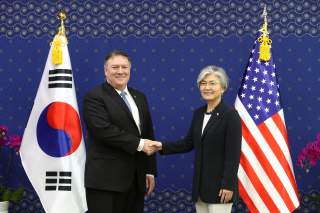The Hanoi Summit – We Asked Narushige Michishita What Happens Next in U.S.-North Korea Relations
"If the same offer is presented in a more pragmatic, working-level setting, the United States might find it reasonably attractive."
Editor’s Note: Looking for more opinions on where we go after the Hanoi summit? Check out all 80 expert takes on where U.S-North Korea relations go next here.
In Hanoi, Kim Jong-un overplayed his hand and lost face when Donald Trump walked away. What are the options for Kim now? There are at least three.
The first is to shoot for a big deal: demand the lifting of most of the sanctions—as Kim did in Hanoi—while offering a full declaration of North Korea’s nuclear capabilities, including the existence of a second secret uranium enrichment plant. Kim demanded too much for too little in Hanoi, asking for the lifting of most of the sanctions in exchange for denuclearization of the facilities in Nyongbyon only. A complete, or at least much more comprehensive, declaration would make Kim’s offer more attractive. This may please President Trump and get the U.S.-DPRK normalization process moving forward. Kim could even play a trick of pledging complete denuclearization and getting the sanctions lifted first, and buy a lot of time by delaying the actual denuclearization process later.
A second option for Kim is to wait for Trump’s position to be undermined while putting pressure on the United States by taking coercive measures such as nuclear and/or missile tests. With the continuing revelations flowing from the Mueller investigation and Congressional Democrats demanding more investigations into Trump’s election campaign and finances, Kim can safely assume that as time goes by, Trump will become weaker. In fact, activities related to a possible missile launch have already been identified in North Korea.
This approach worked in late 2006. President George W. Bush was in big trouble in Iraq; North Korea conducted its first-ever nuclear test; the Republicans lost in the mid-term election; and North Korea hardliners, including then US Ambassador to the United Nations John Bolton, resigned. When these happened, the United States quickly shifted its approach toward engagement with North Korea.
A third option is for Kim to settle for a small-package deal, in which North Korea freezes operations of its nuclear facilities in Nyongbyon, accepts inspectors, and starts preparing for the dismantlement of the facilities while the United States exempts from sanctions inter-Korean economic cooperation such as the joint ventures in the Industrial Park in Kaesong. This might in fact have been what the North Korean delegation proposed in Hanoi as a last-ditch effort to save the summit from failure. The Hanoi summit failed because Kim offended an already highly upset Trump by overplaying his Nyongbyon card. If the same offer is presented in a more pragmatic, working-level setting, the United States might find it reasonably attractive.
Narushige Michishita is a professor at the National Graduate Institute for Policy Studies in Tokyo and a global fellow at the Woodrow Wilson Center in Washington. He is the author of North Korea’s Military-Diplomatic Campaigns, 1966–2008 (Routledge, 2009). He tweets at @NaruMichishita.
Image: Reuters

